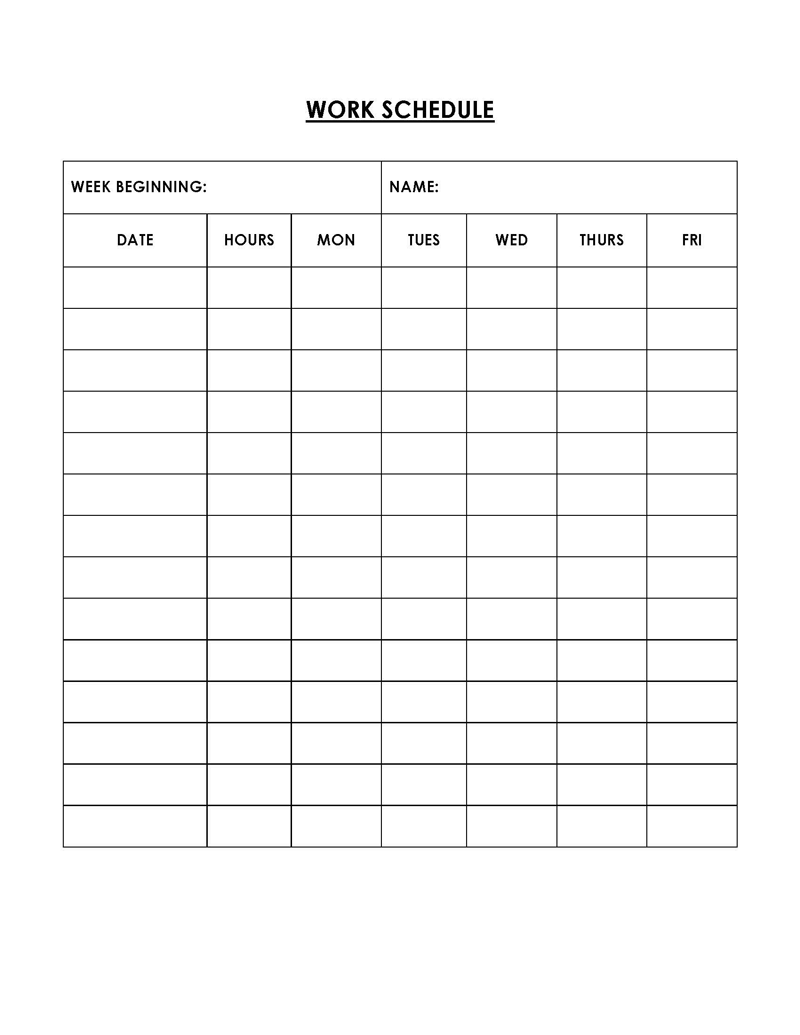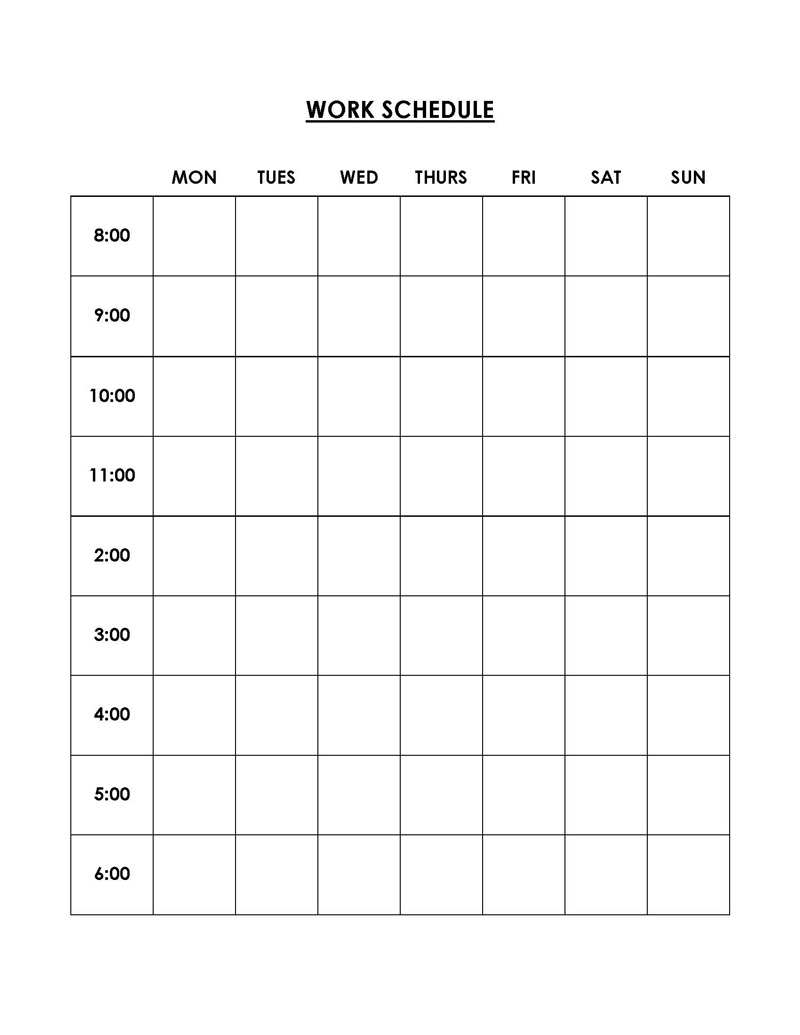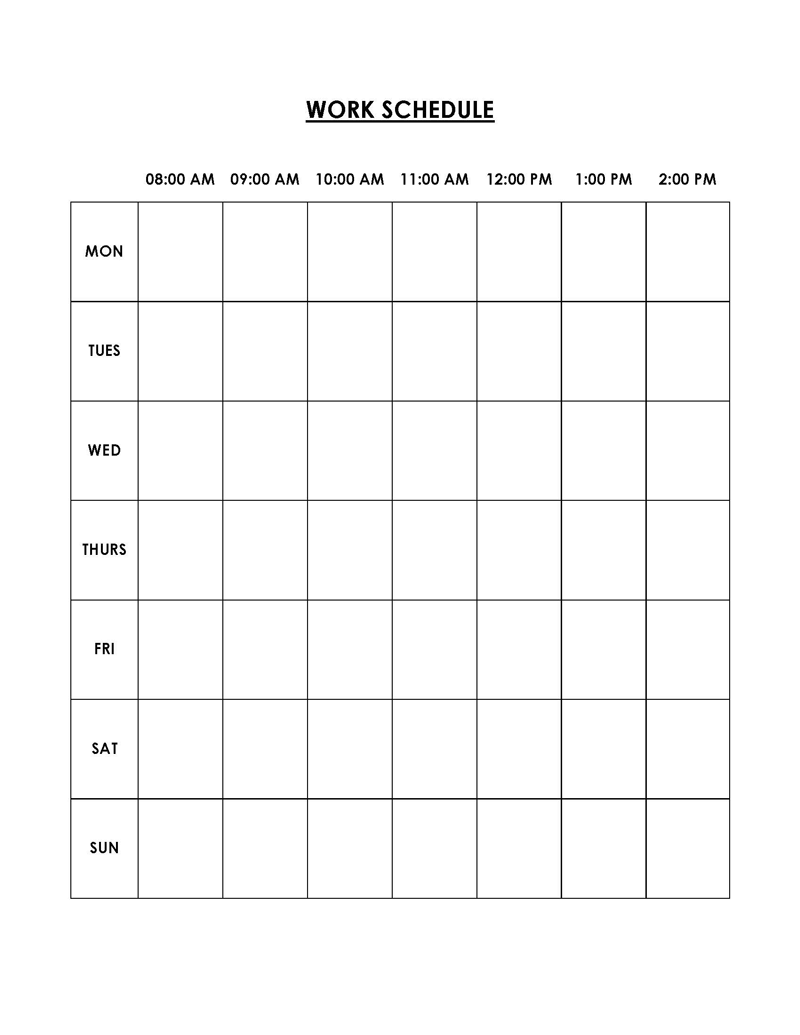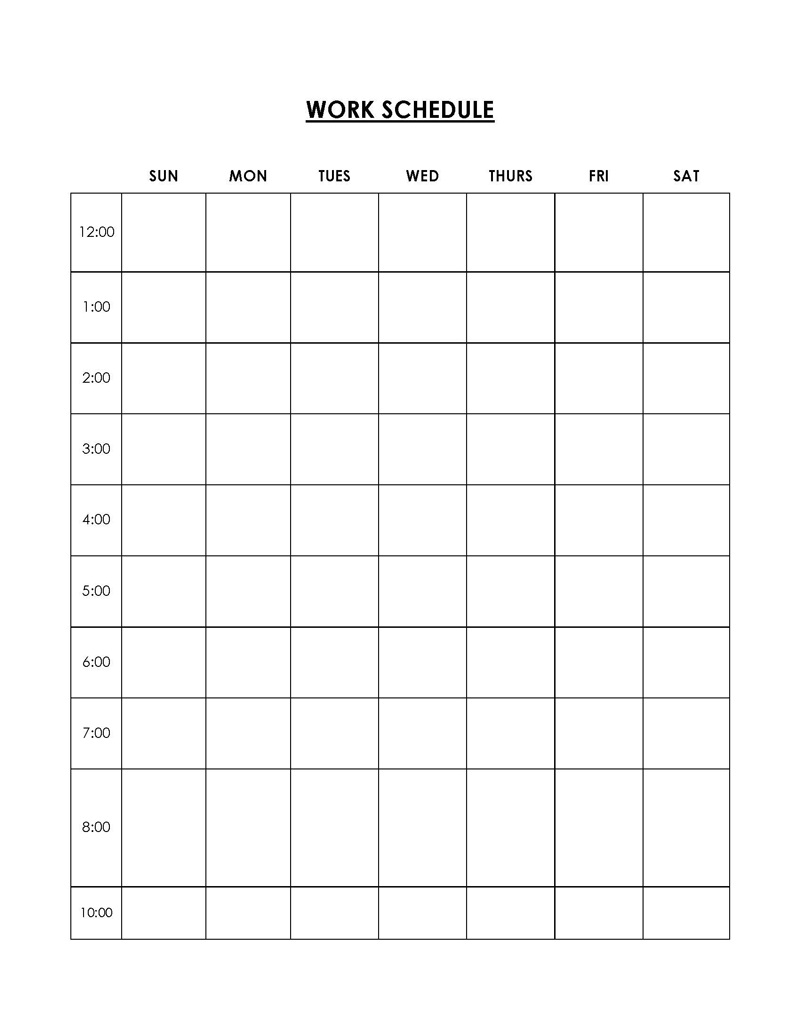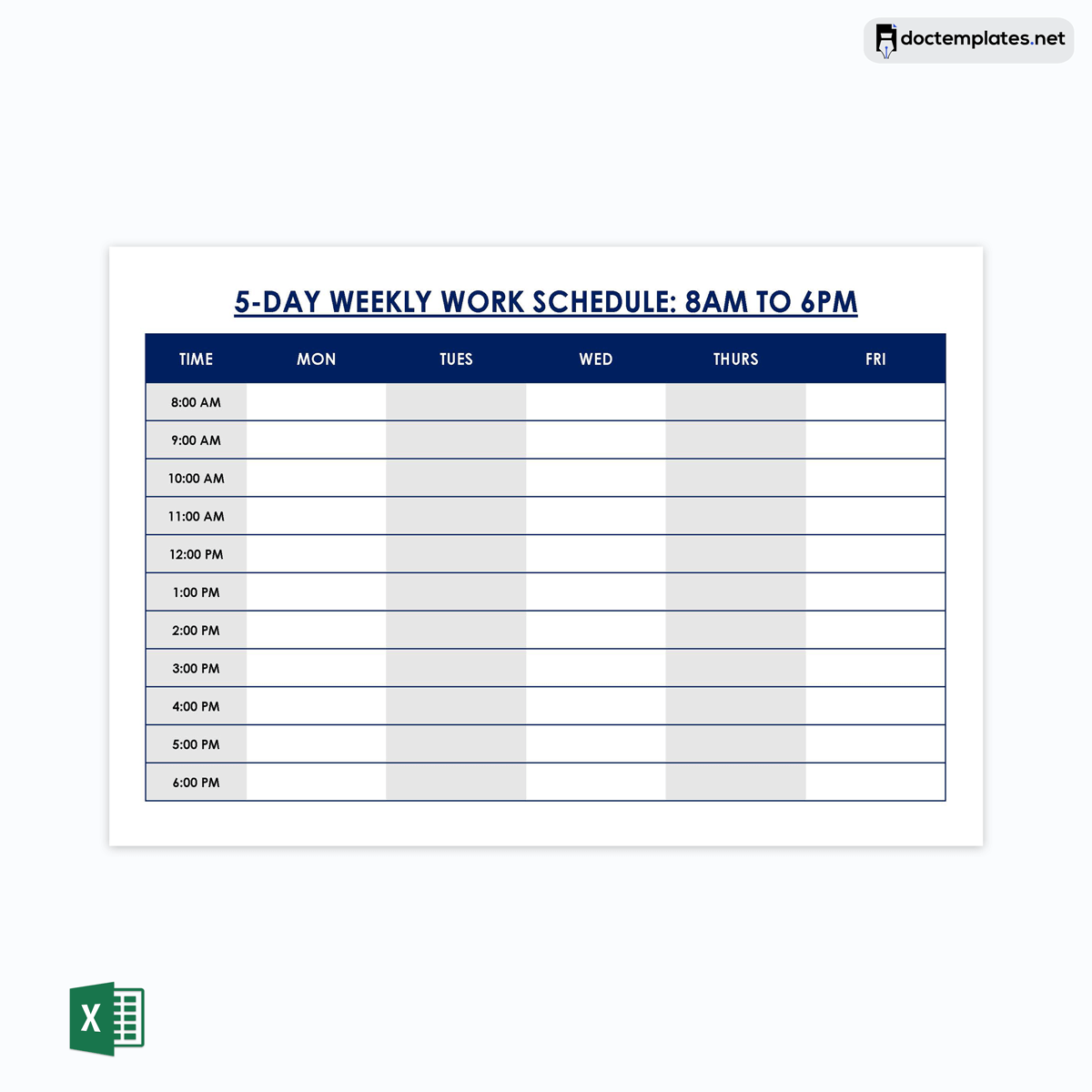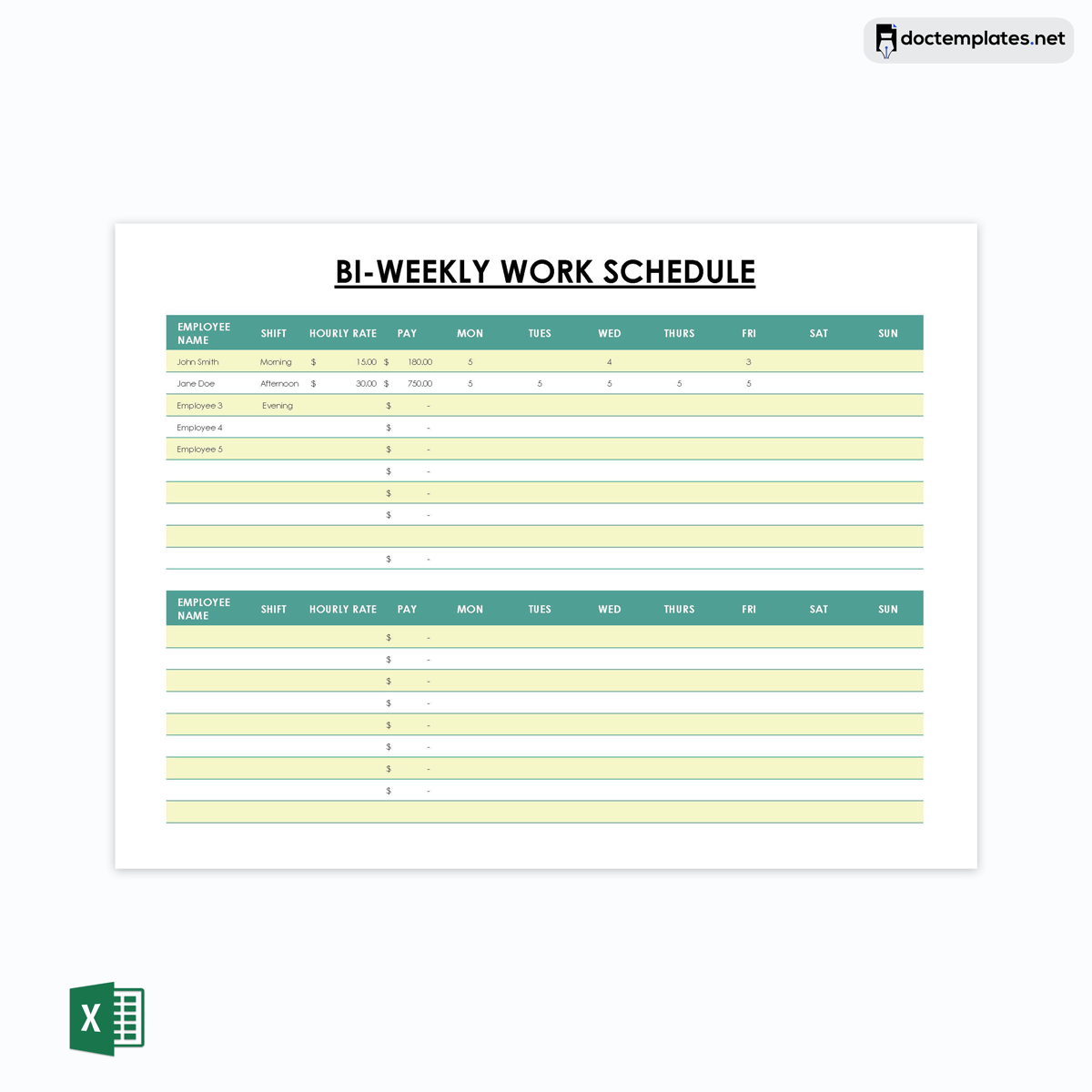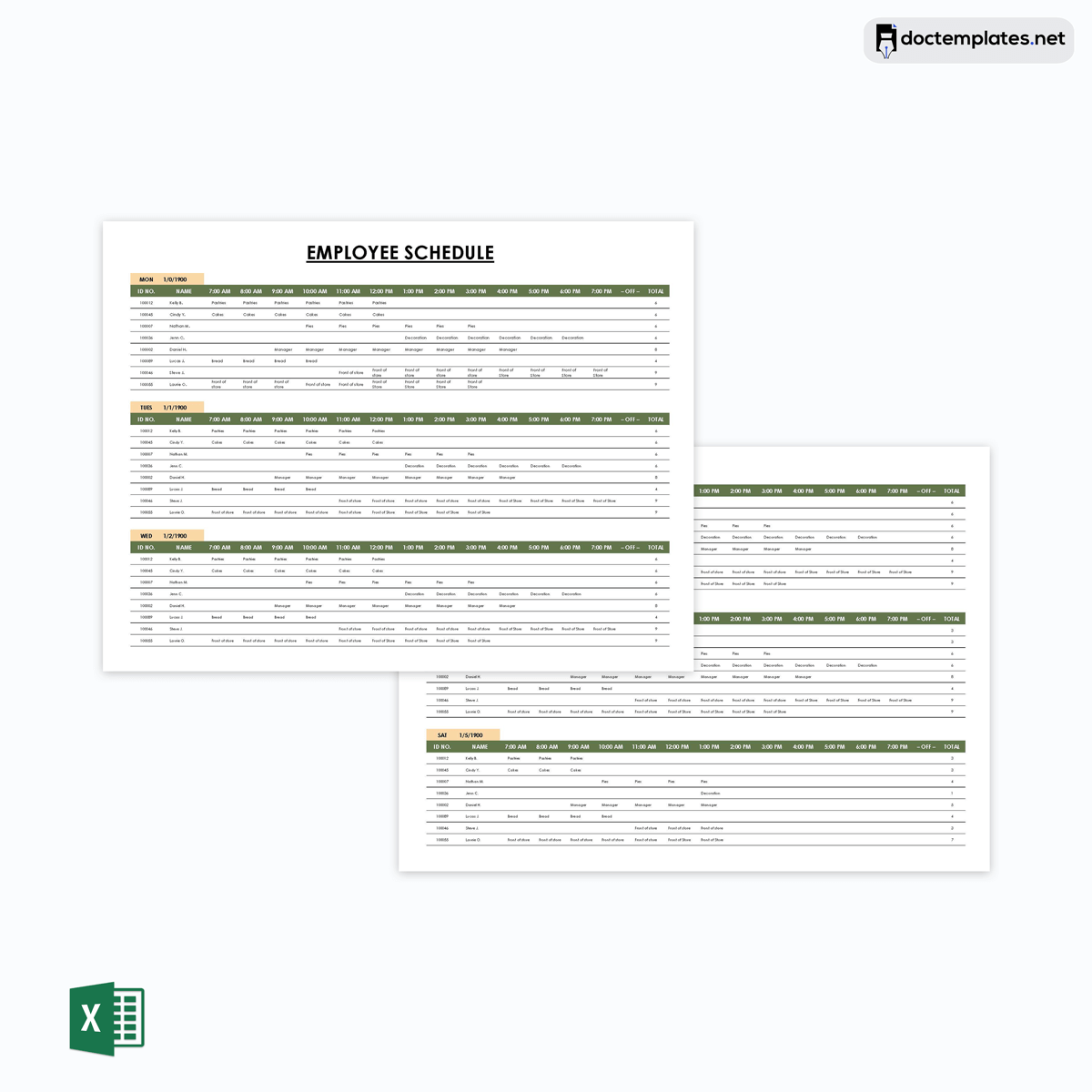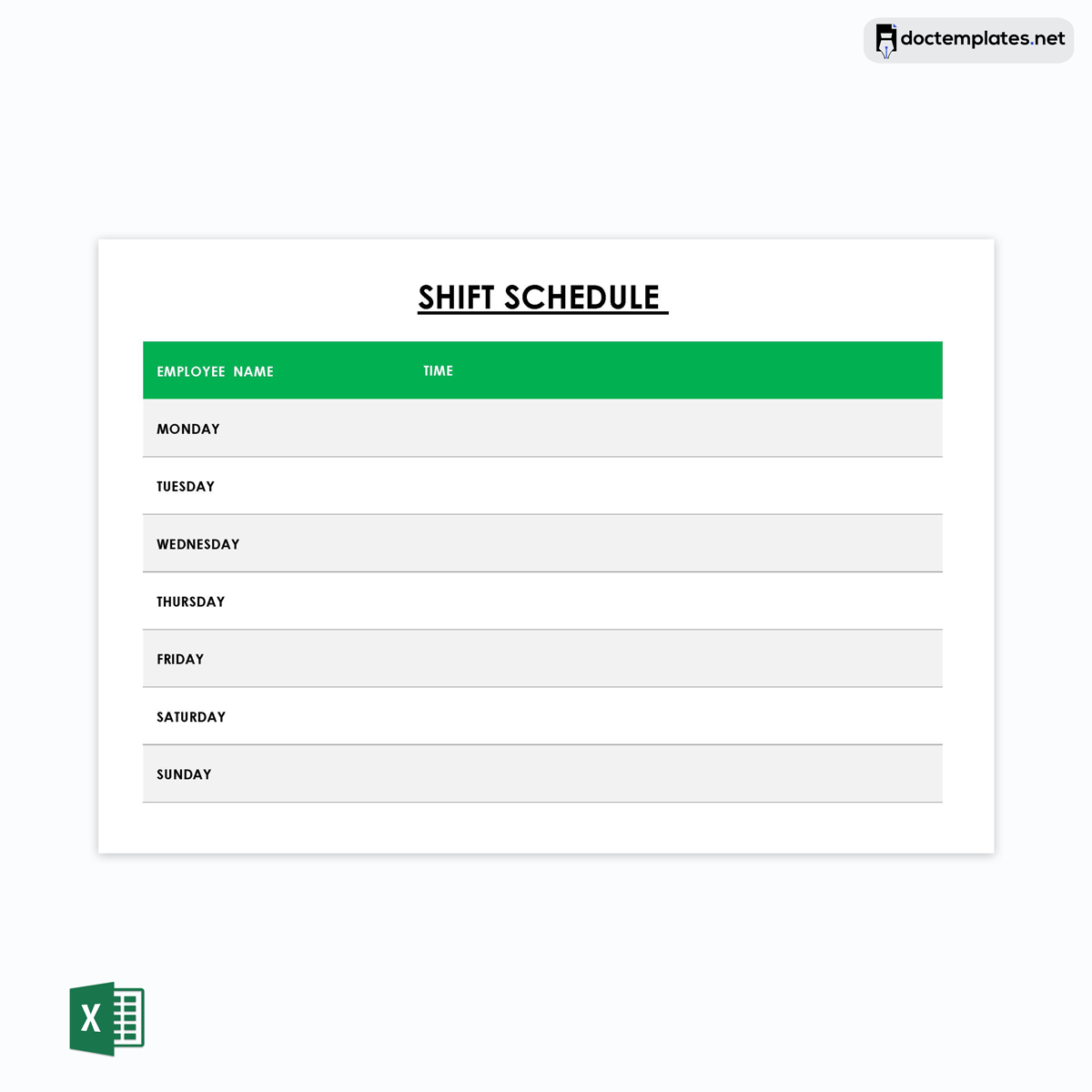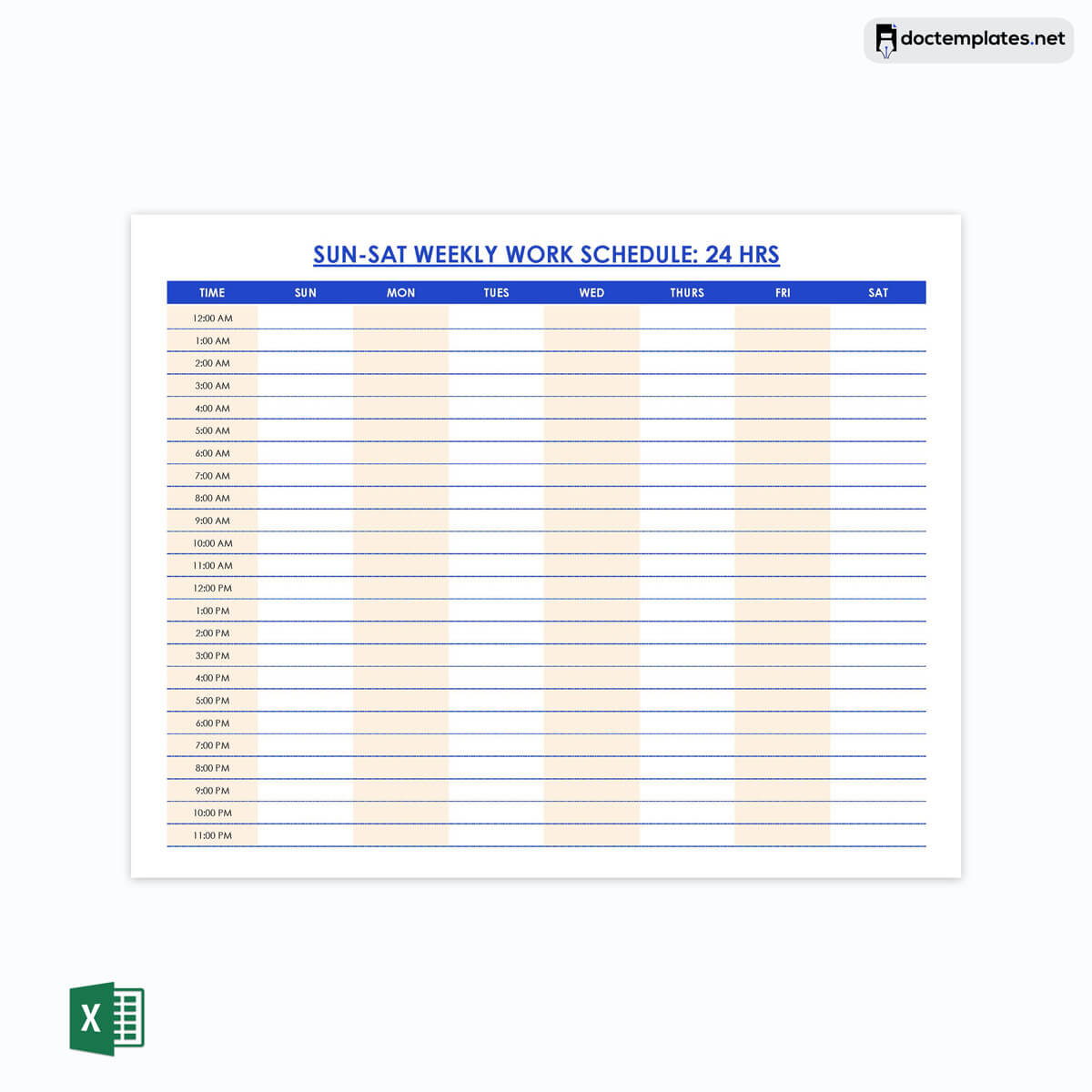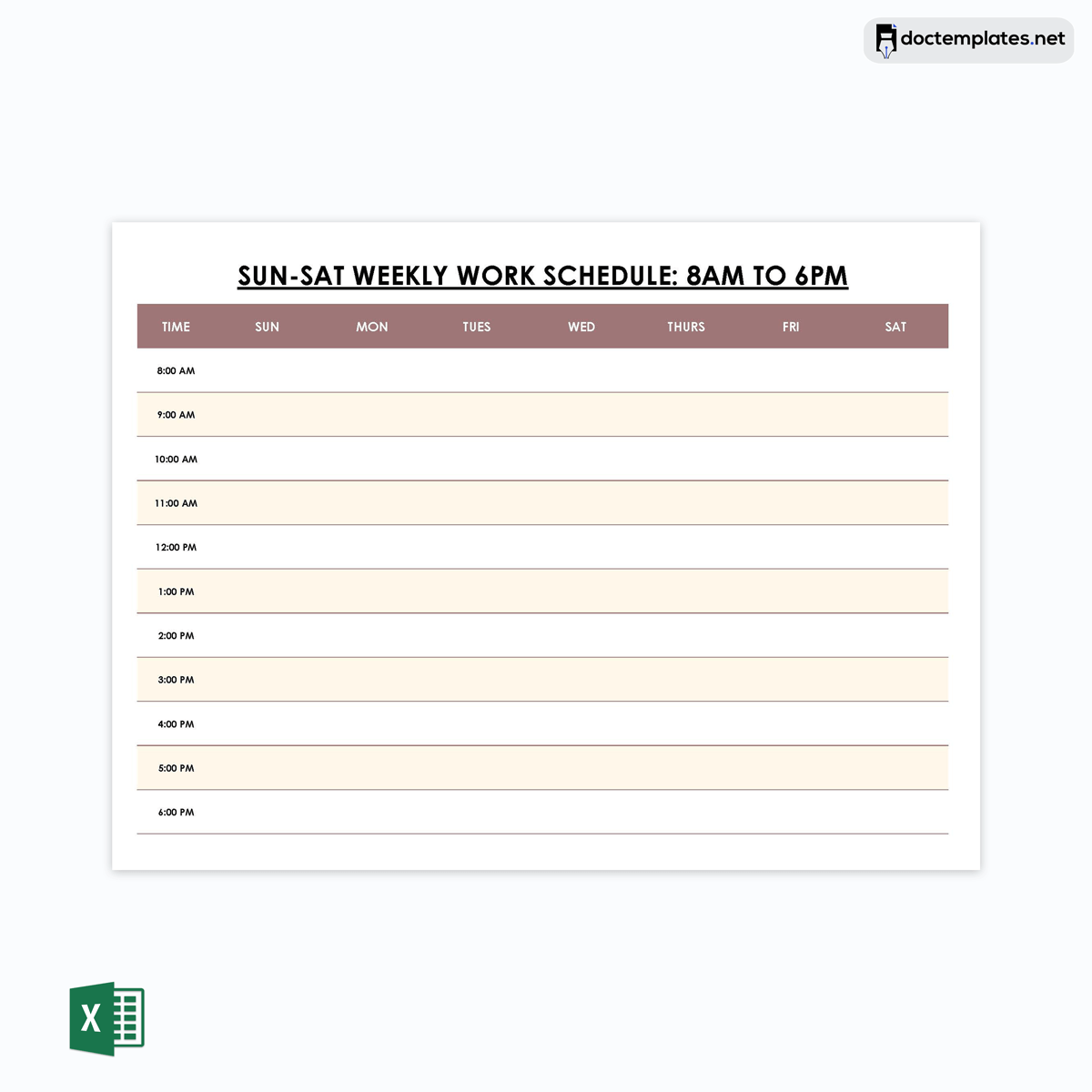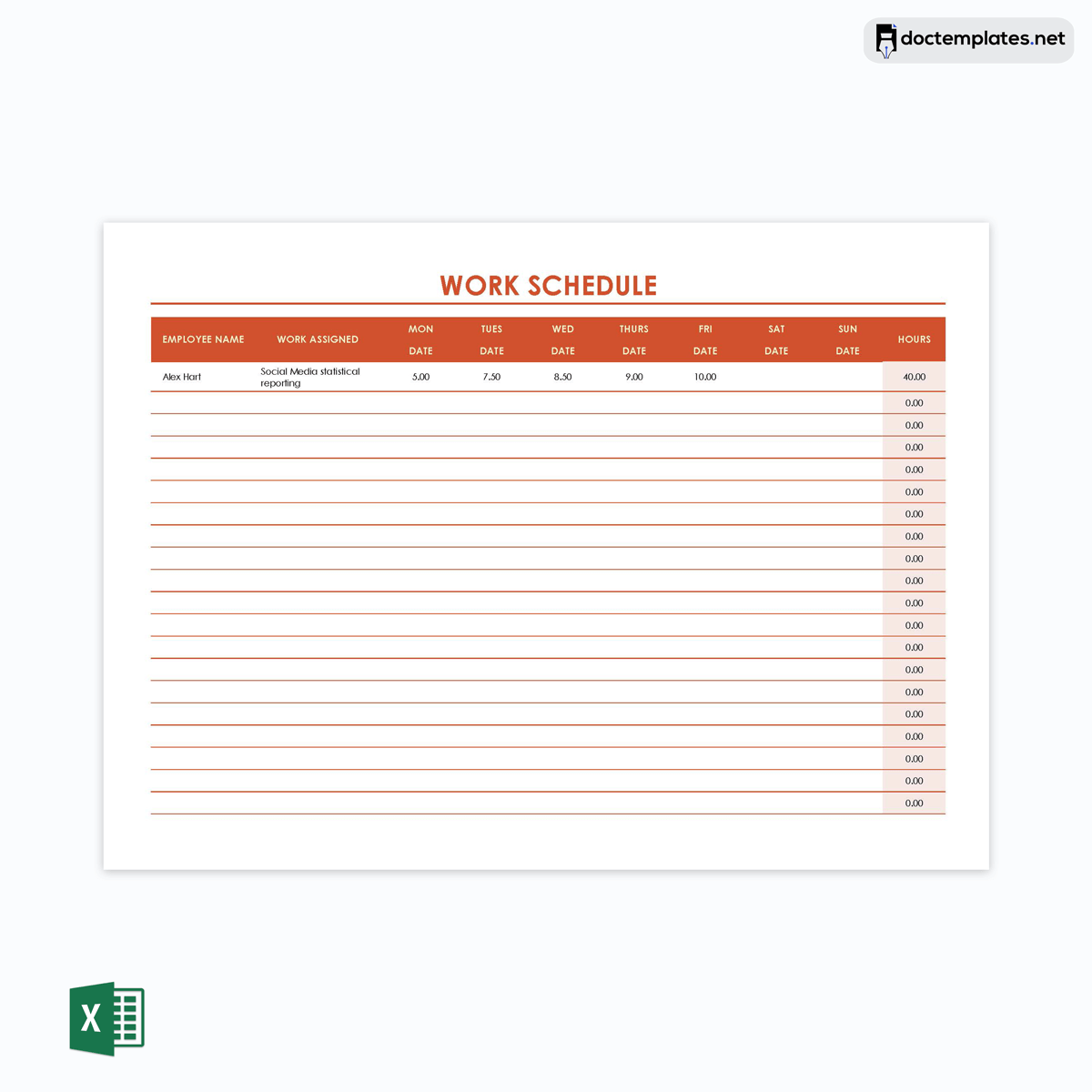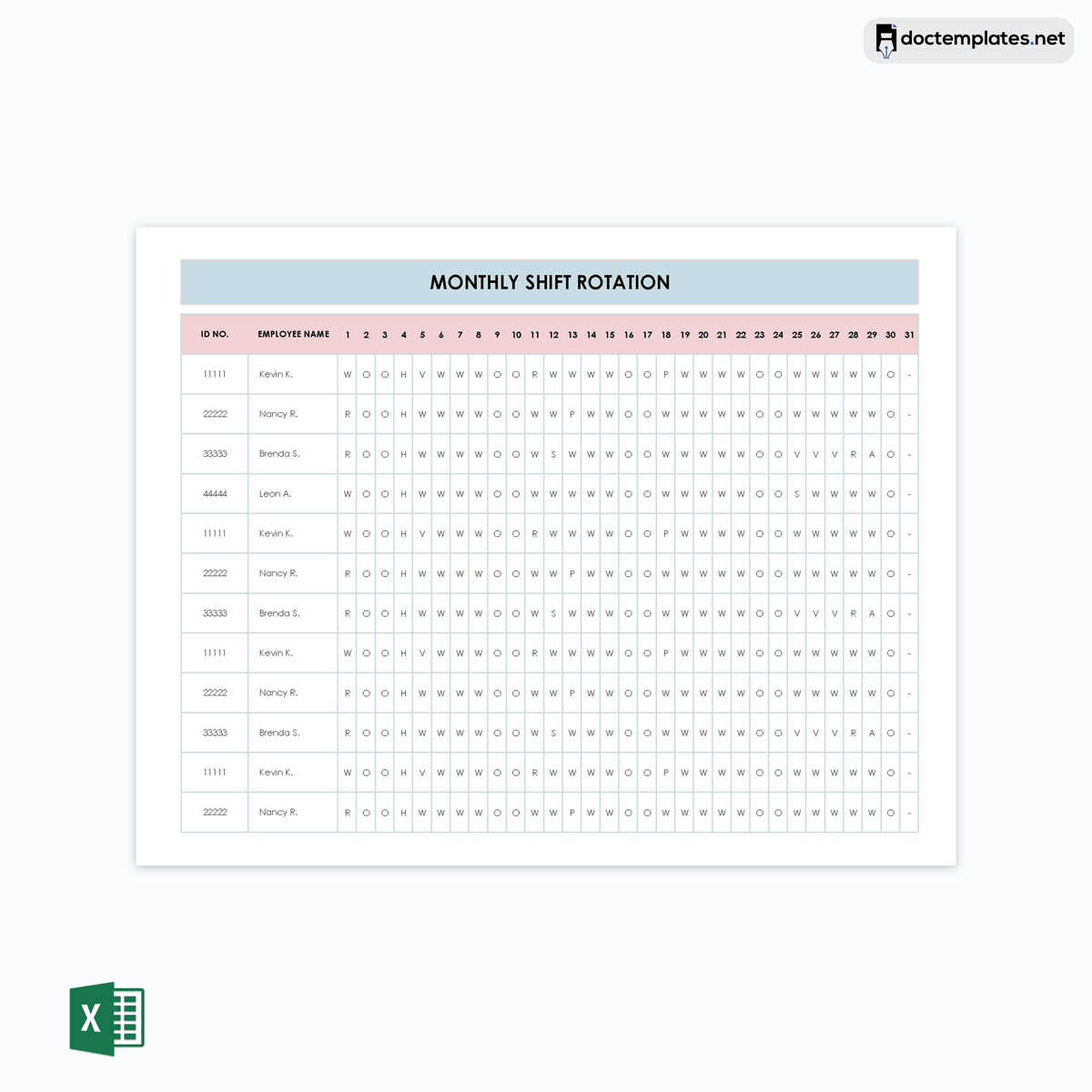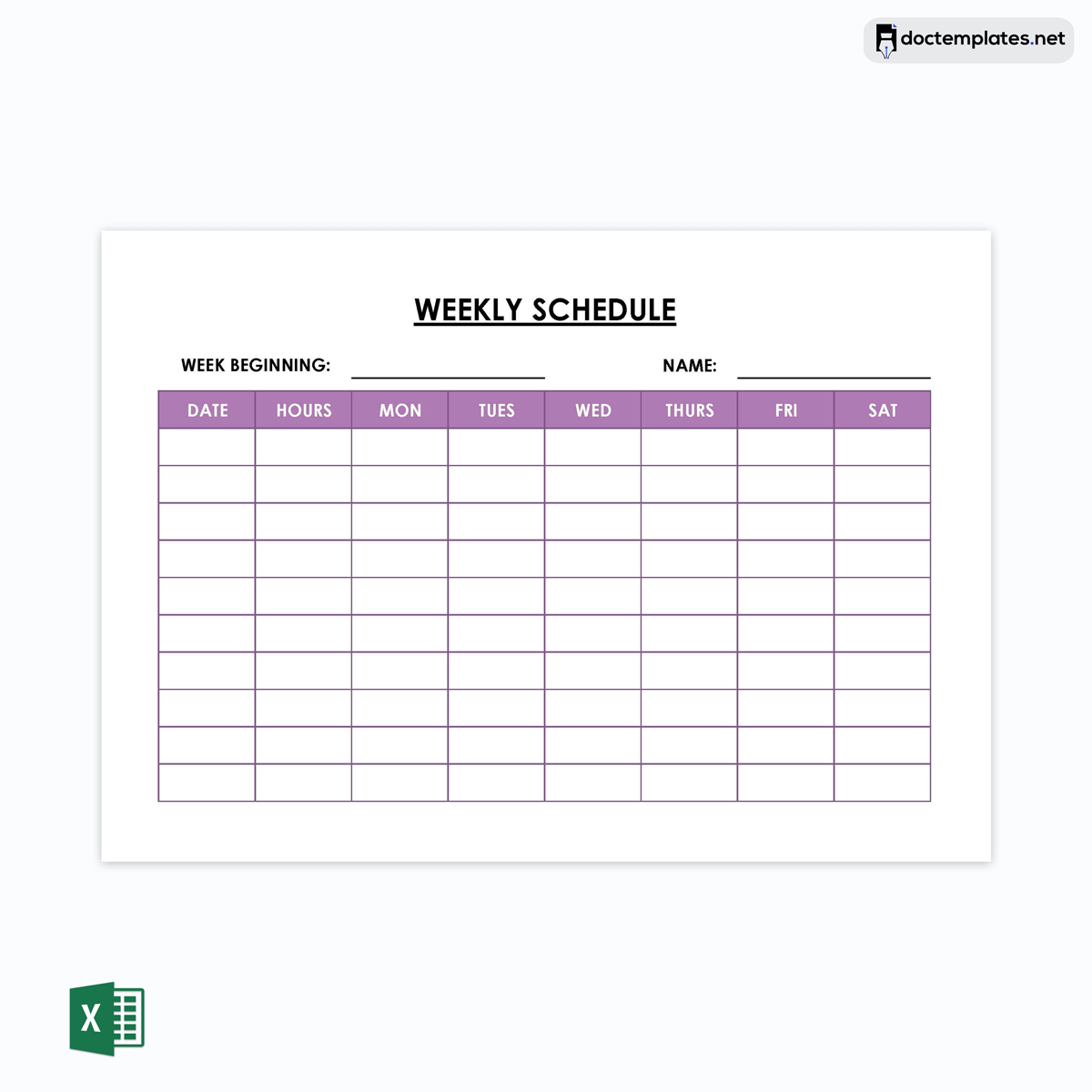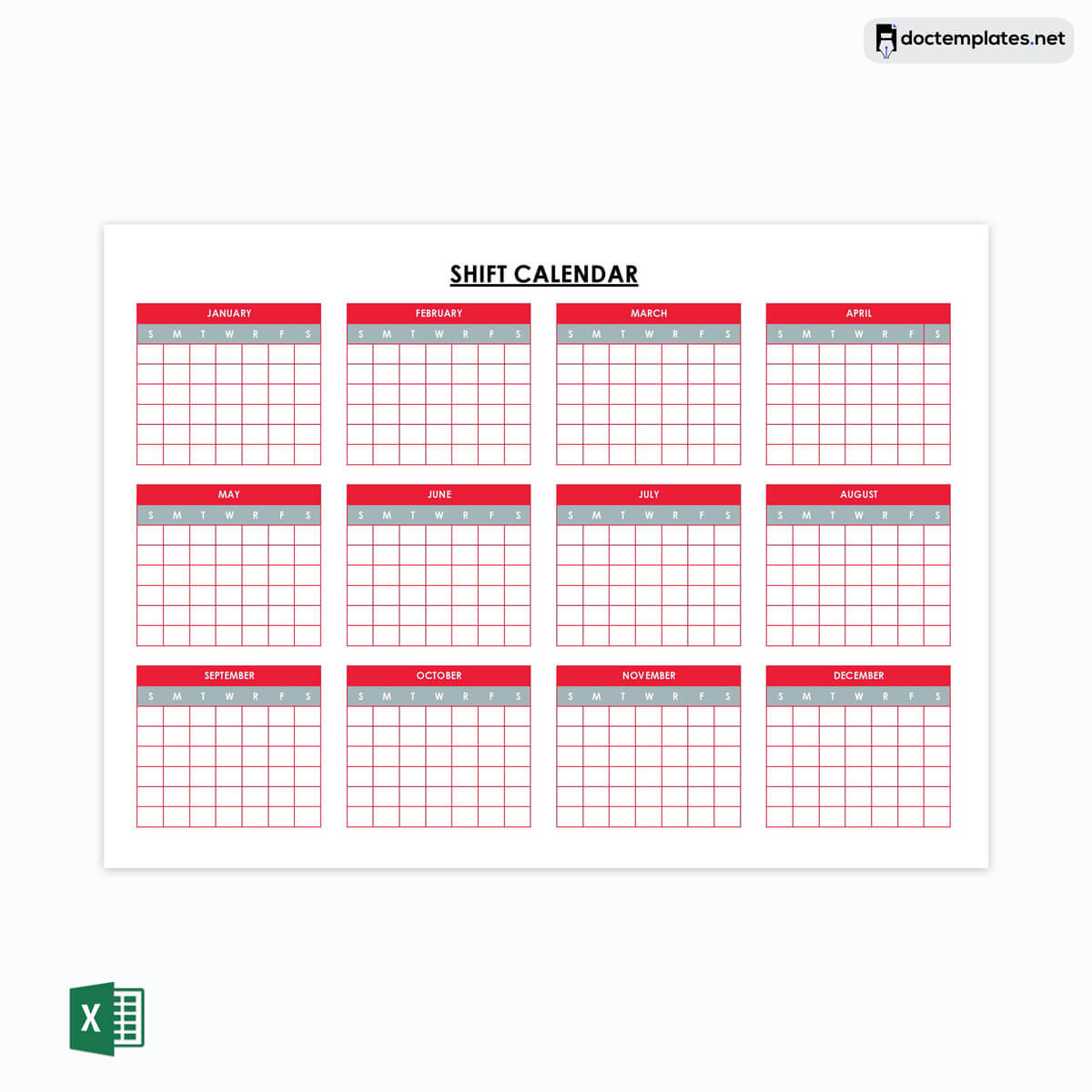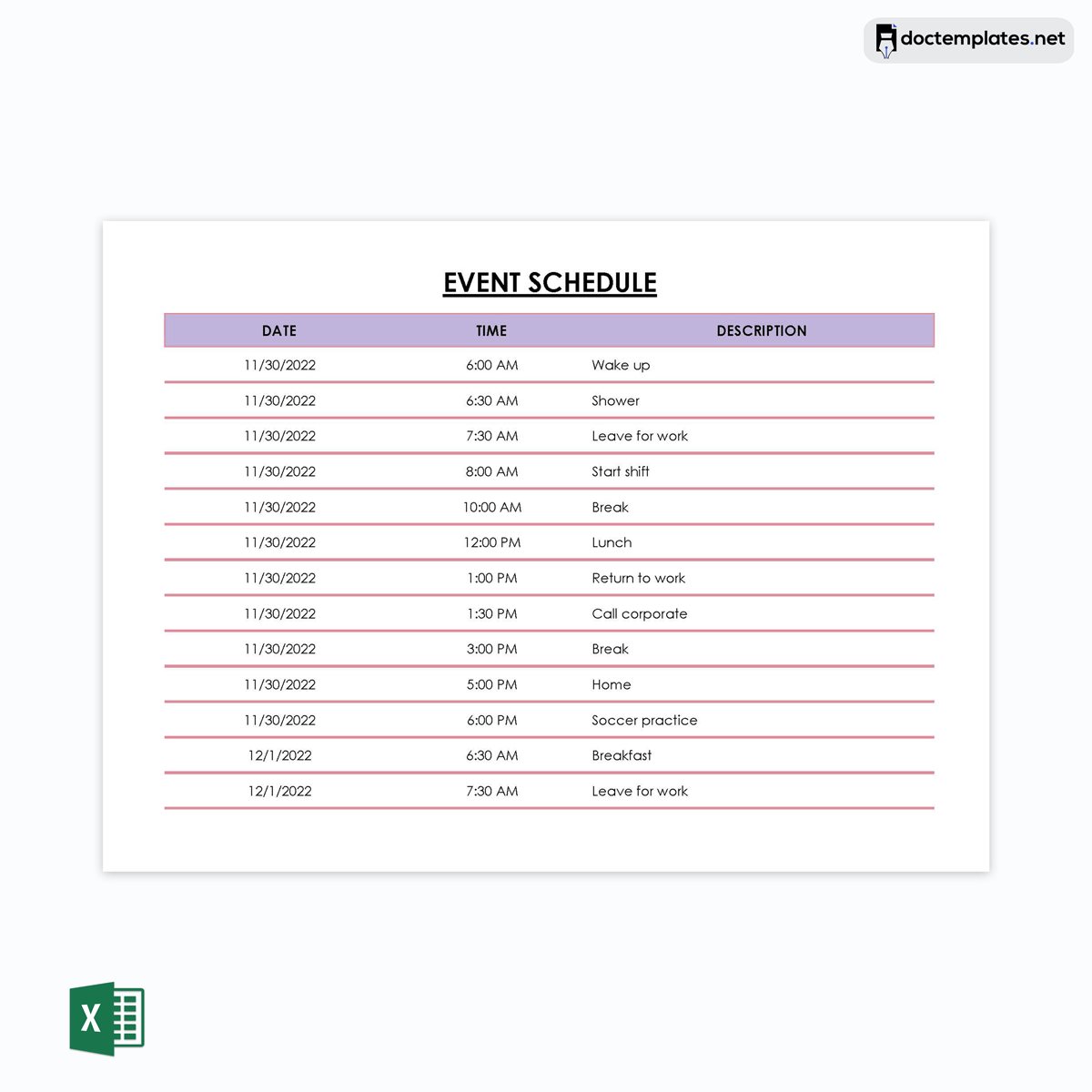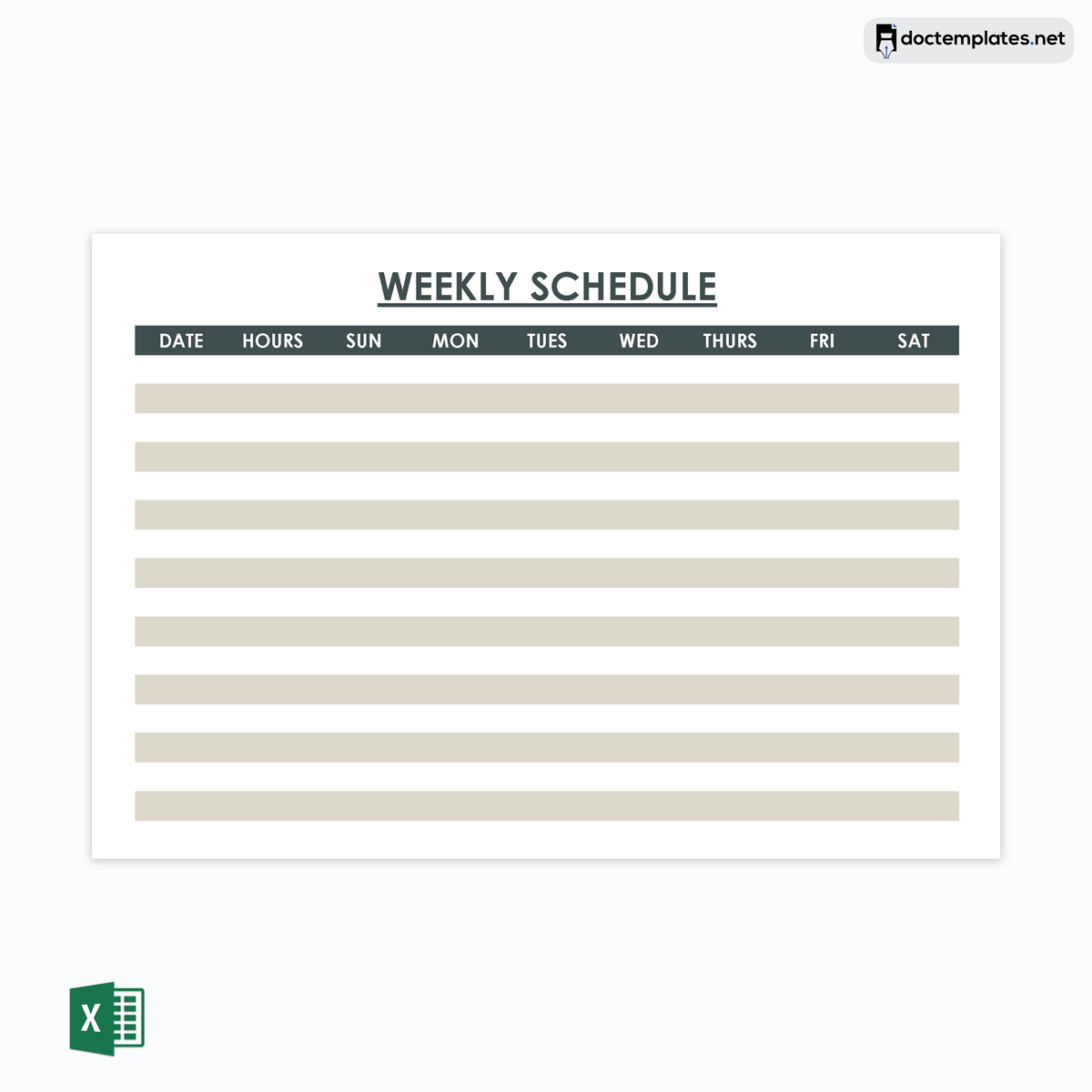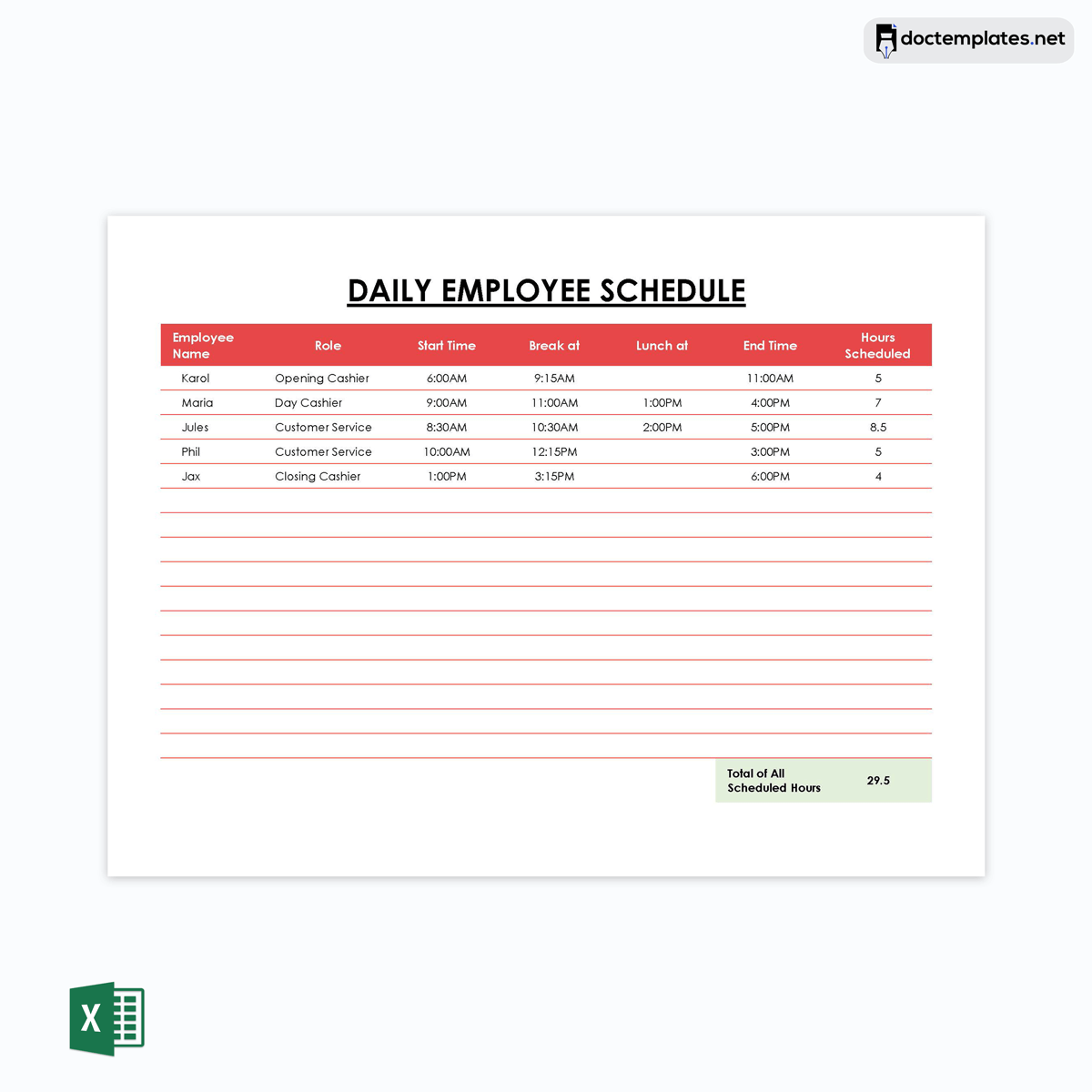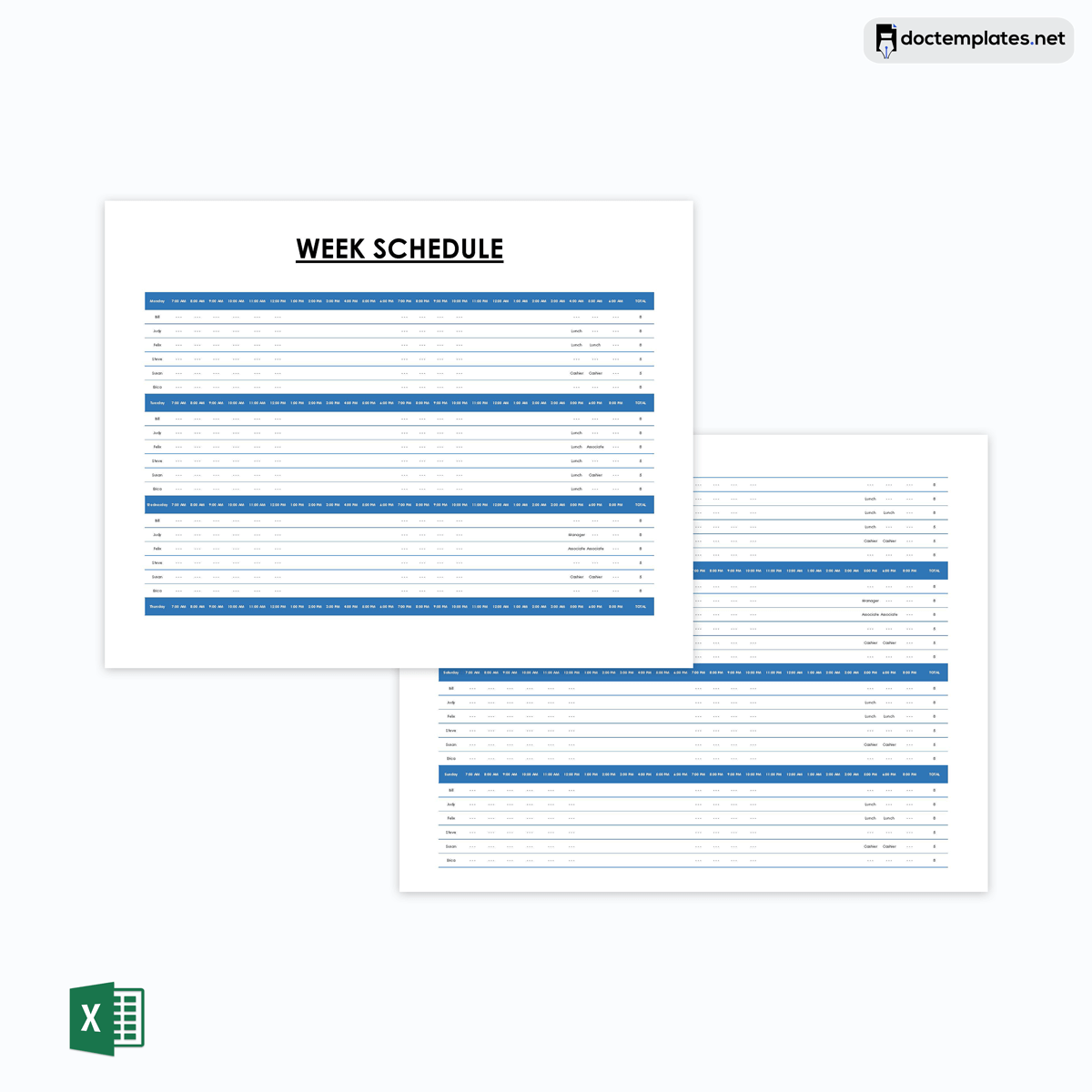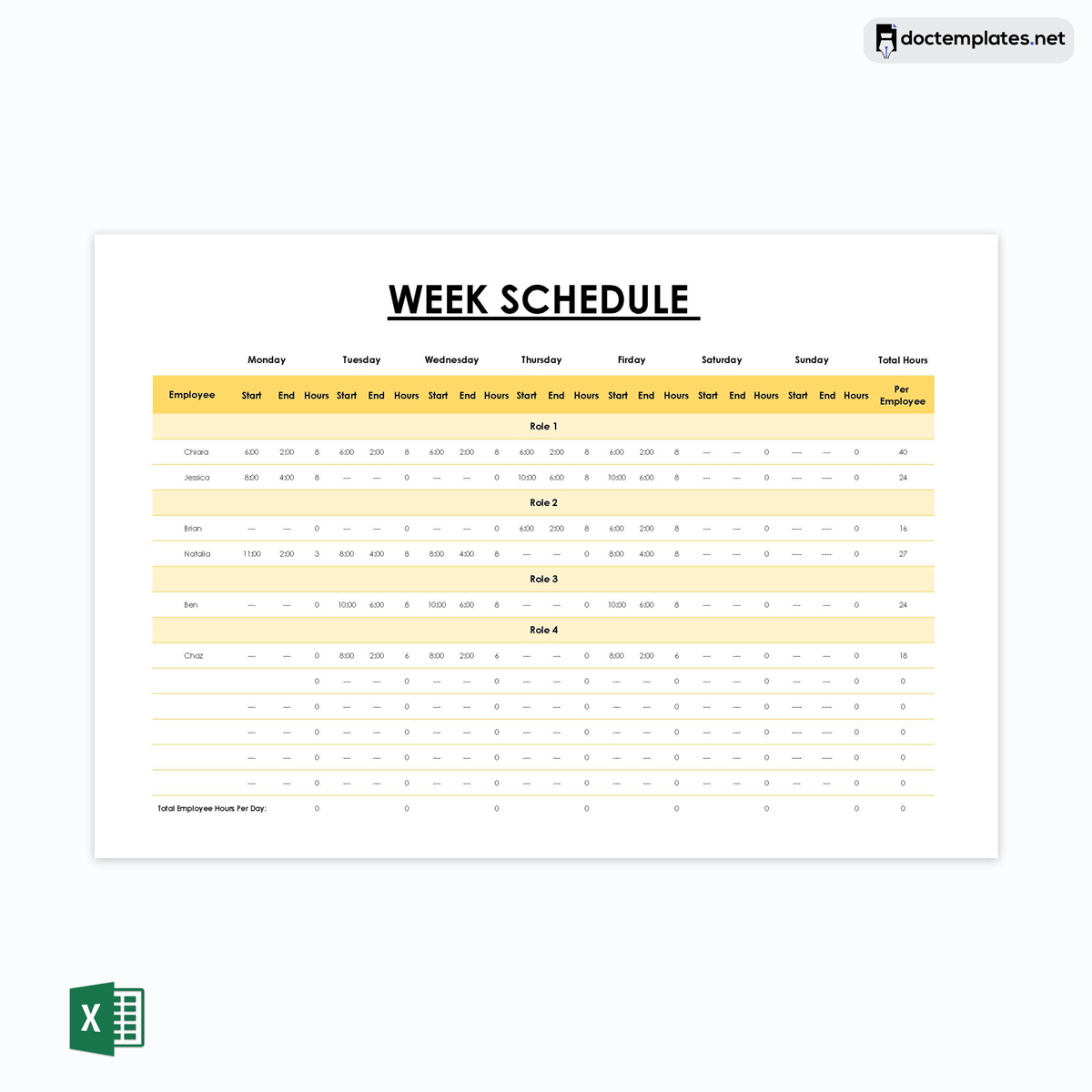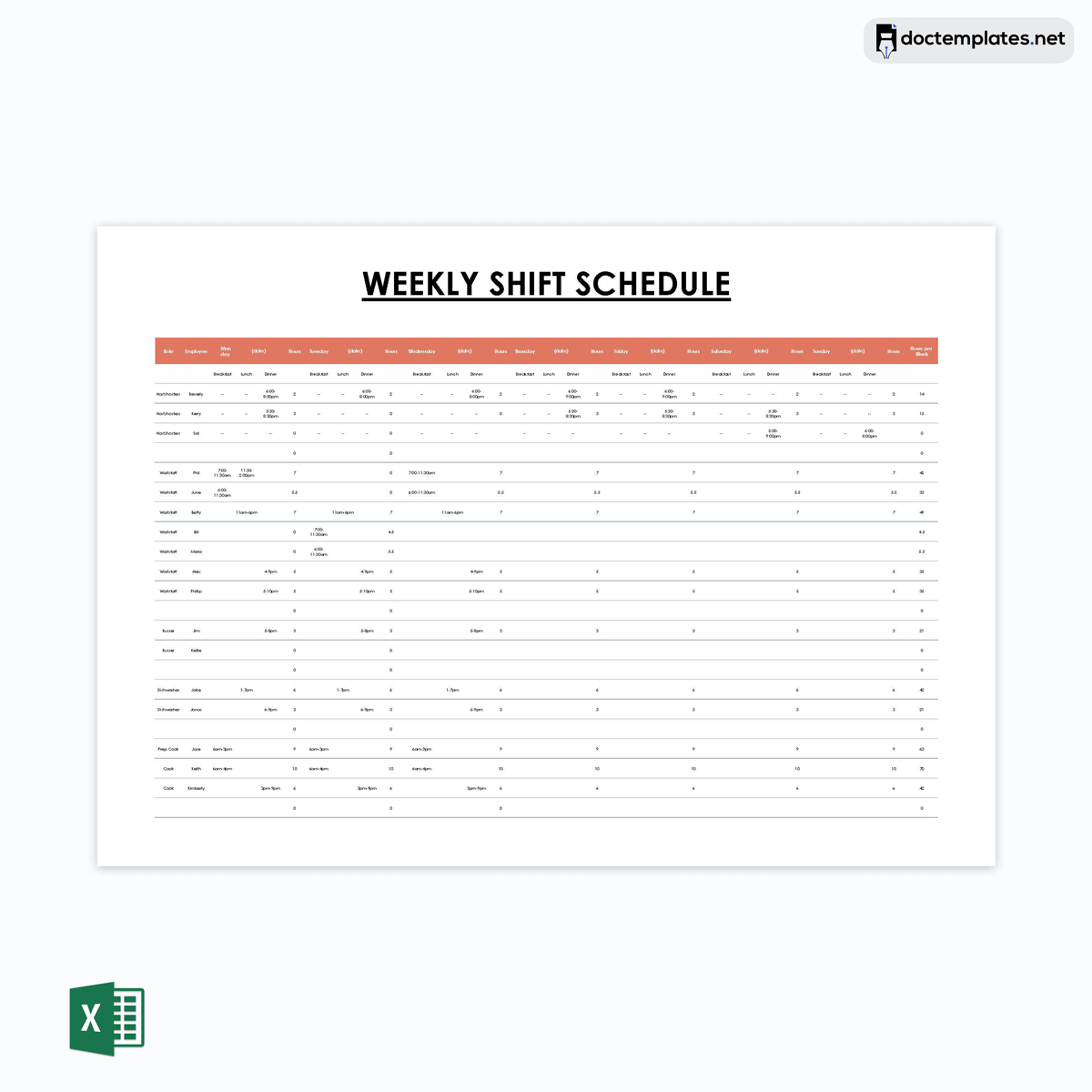An employee work schedule is a document listing the hours specific employees are scheduled to work, typically created a week or month in advance.
It often includes the employee’s name, the time they start and end their shift, and breaks between the stipulated hours. Such schedules are usually created for the employer and employees’ convenience and include policies regarding breaks, lunch periods, and pre-shift and post-shift meetings. An employee work schedule can be created using a template.
A template for making employees’ work schedule is an essential tool for employers. It allows them to record attendance providing valuable insights into how much employees pay attention to their job. This information also helps determine if workers can satisfactorily fulfill their responsibilities and ensure they are not working over or under the stipulated hours limit.
Templates can guide you on what information to include in your work schedule. They are blank and can thus be readily completed to create a befitting employee schedule. Since creating a schedule for employees is an essential aspect of correctly planning your business projects, you should strive to create a scheduling system that is easy to implement and follow. This process can be time-consuming.
However, templates can help reduce the time and workload required to design and craft a professional and efficient schedule for your staff. Alternatively, online scheduling apps or paper-based systems may generally suffice the need. However, if scheduling needs to be done on a larger scale requiring complex formulas, definitions, and calculations, a more sophisticated system may need to be employed.
This article covers practical and relevant information regarding work schedules for employees, how they can be created using a template, etc. It also discusses properly utilizing a template to improve employee productivity, retention, and business efficiency.
Statistics: Recent studies by the American Sociological Review indicated that 174% of employee turnover is usually attributed to the problem of “too much work, too little time.” This is often a result of poor scheduling and an inability to balance the workload across multiple employees. Employees who are forced to work longer than optimal tend to be emotionally exhausted. Similarly, if they are subjected to schedule inconsistencies, they will lose control over their work activities, resulting in increased stress levels and poor sleep quality. Consequently, employee productivity and morale will suffer, often resulting in them leaving your organization.
Work Schedule Templates for Employees
A template is an effective means of showing the structure or format of a document. A template not only saves time but also guarantees excellent quality and flexibility.
If you are experiencing difficulty creating your employee’s work schedules or need to streamline this process, consider downloading the free customizable templates for creating work schedules provided below:
Importance of Scheduling
Effective scheduling is an integral component of your organization. Using a template for scheduling can greatly improve your organization’s workflow as it allows for easy planning, organizing, and coordinating of work activities for employees. Therefore, it is paramount to schedule your workforce correctly, as it can make or break operations by either filling in gaps left by absent employees or causing critical resources to be under-utilized.
In addition, the right scheduling system will give employees enough time to complete tasks. Also, implementing a scheduling template can ensure that all responsibilities are allocated within the correct time slots, preventing any hindrances in the work process.
By utilizing a scheduling template, businesses can avoid cash flow issues, over-utilization of resources, and unnecessary expenses. It will also ensure that critical data is available at the right time to be utilized by other business sections to make informed decisions. In addition, employees with well-defined schedules are likely to show up for work, as a well-designed scheduling template can improve employee productivity, motivation, and loyalty to the company.
Statistical insight: Shiftboard’s Hourly Worker Research report points out that 87% of hourly workers consider having control over their work schedules to be significant in their decision to stay or leave a job. Additionally, 55% of the employees indicated they would leave their job if they could not control their schedules. These statistics show that employees want a schedule that is fair and reasonable.
Factors to Pre-Consider
Practical work scheduling is an art that requires you to be fair and accommodating to the employee’s needs. It also requires you to take a holistic view of the organization to identify any limitations within the workplace.
Here are a few factors to pre-consider when creating a template for a work schedule:
Know your team members
Know your employees and their needs. Make it a point to identify your employee’s unique abilities and skills and determine whether they bring any special skills to the job. Besides, ascertain whether each of your employees has any specific needs you may require to address.
This is beneficial in the long run. It gives you the freedom and flexibility to mix and match strengths, weaknesses, skills, personality types, and work abilities. In addition, this enables you to create a schedule that accommodates your employee’s needs.
Assess your resource pool
Before using a template to create a schedule, assess the nature of your business and the available resources. This will help you accurately predict how much work needs to be done, when, and whether specific critical resources are available or if you need additional resources. An assessment of resources is essential in developing many aspects of an employee schedule and can be used to identify critical resource gaps, over-utilization issues, and time management problems.
Build shifts around the employees
When creating a schedule, try to build it around your employees. This means minimizing gaps in shift coverage and developing reliable and accommodative shifts for employees’ unique needs. To achieve this feature, consider employee traits like efficiency, ability to work well with others, and experience, and put them in the context of your business when formulating your team schedules.
Know your scheduling rules and regulations
Many organizations have rules and regulations regarding how employees are to be scheduled. This is to maintain a regulatory framework that ensures all employees are treated fairly and per their contracts. It also guarantees that the company adheres to local employee rights, overtime, and minimum wage laws.
Establish a communication method
To ensure that your employees know the work schedule, establish a communication system that will alert them of any changes, additional work, or unexpected delays. This is important as it allows you to be transparent with your employees and avoid long periods of unsupervised time for employees who are unsure about what is expected of them.
Enlist those employees who want extra shifts
If you have employees willing to take extra shifts, you use templates that incorporate these shifts into the schedule. This will help you fill in any gaps in shift coverage that may occur due to unprecedented events or unscheduled employee absences. Moreover, prioritizing employees’ scheduling needs and preferences leads to job satisfaction and higher retention rates.
Fact check: Effective work schedules must be realistic, allowing employees real-world flexibility. On the other hand, having an overly restrictive work schedule can cause issues and lead to unproductive employees. Studies indicate that employees who can manage their schedules in real-time are 6X more likely to complete their tasks and feel more invested in their work than employees who are not.
Creating Work Schedule Template in Excel
Templates come in many different formats and forms. You can use spreadsheets, pen-and-paper, or online scheduling apps to create your schedules. However, the easiest and perhaps most effective way to create a work schedule is by using Excel. This is because Excel allows you to create and design your template by taking advantage of the robust tools and functionalities that come with the program.
Excel templates for work schedules are also clean and concise and can be customized to suit your workforce’s needs. Due to their ease of use, you can quickly determine which employee needs to work at what time and track payroll hours. You can also easily plan for your workforce needs in advance.
To create an effective template using Microsoft Excel, follow the easy step-by-step guide outlined below:
Step 1: Open a blank spreadsheet
To begin, launch the Microsoft Excel program. Next, you can choose a pre-filled template for scheduling your employee’s work or create a blank workbook from scratch. To create your blank spreadsheet, go to the ‘File’ menu and select ‘New.’ A blank spreadsheet will be opened. Next, choose a preferred title for your spreadsheet, such as “XYZ Employee Schedule Template,” and save it.

Step 2: Insert column headings
After creating a blank spreadsheet, insert column headings for the various work schedule elements in the template. For example, if you are creating a weekly work schedule, you must create a column to track the employee’s name and days of the week when they should report for work.
So, consider including column headings for the days of operation per week with their corresponding dates. You can also insert other categories of schedule information such as shift start and end time for each work day, total hours worked, tally pay, and so on. The information to include in this section depends on the purpose of making a template for the work schedule, so you can add or remove columns as desired.

Step 3: Fill in the employee’s names
Once the column headings are ready, you can fill in your employees’ work schedules in the template. To do so, click on the column heading “Employee” and enter your employee’s name in that row. This is done by either selecting the employee’s name from a list or typing in their name.
Again, try to write or ‘sort’ the names alphabetically so your employees can easily find their names. Besides, remember to include your employee’s full name to avoid confusion in case there is more than one employee with the same first or last name.

Step 4: Determine work times
Once you have entered the names of your employees, it is time to add their respective work times. For example, if you plan a weekly schedule, add the start and end times using the columns provided for this information. For biweekly or monthly schedules, you will have to select multiple work days from a dropdown list of these days to make your work easier.
You can also develop a formula that will automatically calculate the start and end times of the employee, as well as the “Total Hours Worked” and “Tally Pay” columns if you include them in your template for scheduling employees’ work.
To automate the spreadsheet, select a cell and click on the ‘functions/formulas’ gear icon. Next, choose ‘Substitute’ from the list of available functions and select the formula you want to use. This will automatically calculate the selected column’s information based on the designated formula.

Step 5: Save the template
After you have entered all the details of your work schedule, save it by selecting the ‘File’ menu and then clicking ‘Save As.’ Choose a file name for the document and save it to your desktop or any other location where you can easily find it. Consider saving the spreadsheet as a new document with a different file name so that the template will be available for the next scheduling round while maintaining a record of past employee schedules.

Step 6: Share the schedule
Once you have saved your new template for creating your work schedule, you can customize it further and share it with your employees by selecting ‘File’ and clicking the ‘Share’ option. You can also print and post it somewhere at the workplace, where it will be accessible to all employees.

Statistics: A research report by TSheets indicated that over 50% of employers spend at least two hours a week making their employee’s scheduling. Therefore, you need to get strategic and devise ways to streamline this process to save time. A template from Excel is one way of automating this process, saving you substantial time and effort.
Do’s and Don’ts
Companies that have succeeded with staff scheduling have a few things in common. They divide their work schedule template into clearly defined sections, designate an employee responsible for each section, and ensure that workers know their duties well in advance.
The following are the do’s and don’ts of employee work schedules:
Do’s
The factors to consider when creating a work schedule for your staff members include the following:
Publish the schedule quickly
Identify the dates and times you need each employee to work and when they start and finish. Ensure each employee receives a copy of the final schedule or has access to it as soon as possible to ensure they are aware of their assigned schedule.
Allow employees to do some of the scheduling
Allow your staff to determine their hours of work. This can be done by inputting the templates into work scheduling software that allows employees to determine their availability and work times. You can also stipulate a deadline by which employees should submit the changes they wish to implement on an already-developed work schedule.
Let employees find their substitutes
If an employee cannot fulfill their duty due to unexpected events, allow them to assign another employee to cover their duties. This creates a sense of trust in the workplace and ensures that your staff can always contribute in the way they can. This also reduces their workload when you let them find their substitutes, but make it clear that all trades, replacements, and substitutions have to be approved by you.
Draft an availability chart
An availability chart outlines which employee is available to work at what time. By having an availability chart, you will quickly identify who can be assigned to a particular shift when there is no one to cover it. You can also track who is available for a specific shift and add more shifts or change others when needed.
Have a backup plan
If you need to assign a substitute for a particular role, make sure you have a backup plan. This will help you prepare for eventualities and lessen the probability of scrambling and searching for someone to cover the role last minute.
Use the right technology
Accurately predicting staffing needs can be a difficult task. First, you must use the right technology to get the most out of your staff scheduling. This means choosing software that will allow you to dedicate certain hours for each of your staff members and that can be customized according to your specific needs.
Be prepared for the changes
Your staff scheduling will only be as good as your ability to identify, accommodate and react to change. Therefore, when creating your staff schedule, you should always keep in mind that there is a possibility that certain things will change.
Review your employee schedule regularly
Since everything changes constantly, you should review your schedule regularly to ensure that all the changes have been incorporated correctly.
Don’ts
You should avoid some common scheduling mistakes to ensure that you create a practical and realistic schedule for your employees.
These include:
Scheduling employees for the wrong position
When creating your staff schedule, you need to think about the individual skill sets of each employee and how they can best contribute to the company. If you assign them tasks or duties that do not utilize their skills suitably, they might be unable to perform well or be dissatisfied at work.
Under or over-scheduling employees
When creating your schedule, you should consider the work required in a specific time frame and assign shifts accordingly. The same thing goes for employee breaks; if you do not allow employees enough time to take their breaks, they may become disgruntled and unproductive. Also, avoid giving a single employee too many shifts in any given schedule period. This is significant, as it helps you reduce overall labor costs since you will not have to pay out more for overtime.
Double-scheduling an employee
Avoid scheduling an employee to work two jobs at the same time. This is a significant scheduling mistake and can result in serious repercussions such as burnout, low productivity, and a high turnover.
Final Words
When creating your employees’ work schedule, make it a point to accommodate your employee’s needs while also catering to the needs of your business. Make a plan to ensure that your staff schedule is correct. Creating and implementing a flexible and adaptable schedule will give you a productive, highly motivated, and satisfied workforce.
You can quickly and easily create a befitting template for scheduling your employees’ work from scratch using Excel. You can also use pre-made templates for a more insightful way to conceptualize your employee’s schedules. Then, regardless of the form and format you use to create your schedule, ensure that each shift has been staffed appropriately and that your final document contains no scheduling errors. Finally, always communicate the schedule to your employees ahead of time to ensure that they are aware of their shifts and make scheduling an ongoing process.
